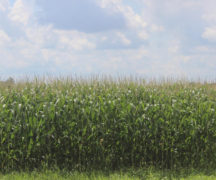By JAN McLAUGHLIN
BG Independent News
The avian flu reported earlier this week at a Wood County dairy operation has been contained to that farm, according to Ohio Department of Agriculture Director Brian Baldridge.
This is the first case of bird flu in a livestock operation in Ohio.
An estimated 10 percent of the dairy herd has been contaminated, Baldridge said on Thursday. Baldridge would not identify the dairy operation where avian influenza was found, but said it is a “large dairy.” Some large dairy operations in Wood County have as many as 4,000 cows.
The local dairy operation reportedly received cows on March 8 from a Texas dairy, which later reported a confirmed detection of Highly Pathogenic Avian Influenza among its livestock. Baldridge said the cows transported to Wood County came from “ground zero” of the bird flu cases.
The cows were transported to Ohio prior to the cows in Texas showing signs or symptoms of the virus, he said.
Once in Wood County, some of the cows began showing signs of bird flu – decreased appetites followed by significantly decreased milk production, Baldridge said.
The cows tested positive for avian flu, and ODA sent the results to a USDA lab for confirmation.
The ODA is working with the dairy, but no lockdown orders have been issued since the farm is self-containing the infected cows, Baldridge said.
Avian influenza has now been confirmed in dairy cows in seven states. The USDA is conducting tests to determine if the illness is spreading through direct contact between cows, or during the milking process when milking equipment is moved from cow to cow, Baldridge said.
State and local veterinarians are working with the owner of the Wood County dairy to isolate the cows, which are recovering from the illness, Baldridge said. Milking of the infected cows must continue, but the milk doesn’t go through the production line, he said.
While cows are able to recover from avian flu, many birds cannot, Baldridge said.
According to the CDC, avian influenza viruses are very contagious among birds, and can sicken and even kill certain domesticated bird species, including chickens, ducks and turkeys.
Infected birds can shed avian influenza A viruses in their saliva, nasal secretions, and feces. Susceptible birds become infected when they have contact with the virus as it is shed by infected birds. They also can become infected through contact with surfaces that are contaminated with virus from infected birds.
Highly Pathogenic Avian Influenza viruses cause severe disease and high mortality in infected poultry. The virus can spread rapidly through poultry flocks.
Though rare, HPAI viruses have also caused mild to severe illness in infected humans, according to the CDC.
The Wood County Health Department has been contacted by the ODA, which has asked the affected dairy farm to report any illness among employees to the health department. As of Friday morning, no cases of illness had been reported to the health department.
Because of the serious threat to birds, efforts have been ongoing at poultry farms to keep outside birds from contaminating their flocks.
“The poultry industry has taken huge measures of bio-security,” to keep other birds out, Baldridge said.
Ohio saw a spike in avian flu at poultry farms in October, he said. It was believed that was due to migrating birds spreading the disease. There are no herds being quarantined currently, Baldridge said.
Baldridge applauded the collaboration between the ODA, USDA and the Dairy Association to deal with the bird flu among dairy cows.
“Our dairy products are safe,” he said. “So enjoy your milk, your cheese and your ice cream.”
The USDA, CDC, and the Food and Drug Administration, as well as state veterinary and public health officials, continue to investigate the emerging illness among dairy cows.
According to the FDA and CDC, there is no concern about the safety of commercially pasteurized dairy products due to both federal animal health requirements and pasteurization.
Federal and state agencies continue to conduct additional testing of sick animals and unpasteurized clinical milk samples from sick animals, as well as viral genome sequencing, to assess whether HPAI or another unrelated illness may be underlying any symptoms.
ODA is working with state industry partners and federal agencies to encourage farmers and veterinarians to report cattle illnesses quickly, to monitor potential additional cases and minimize the impact and risk to farmers, farmworkers, consumers, and other animals.





